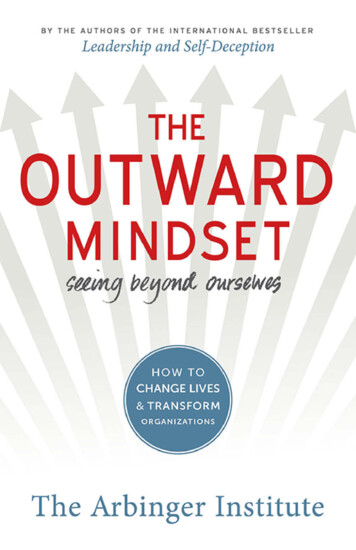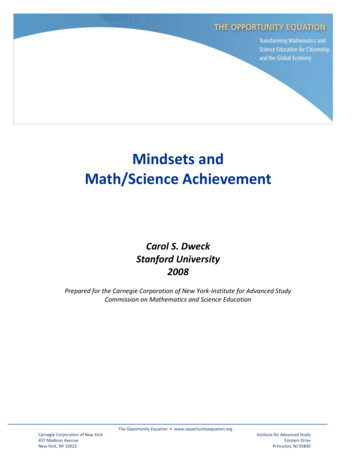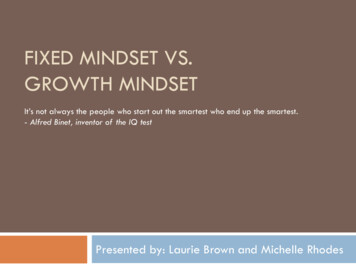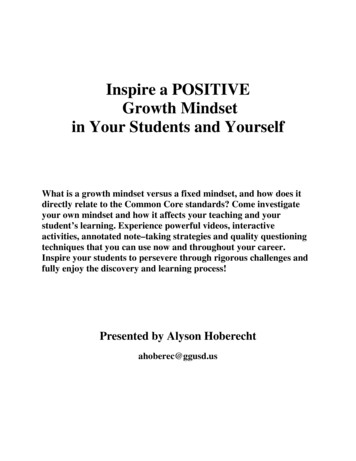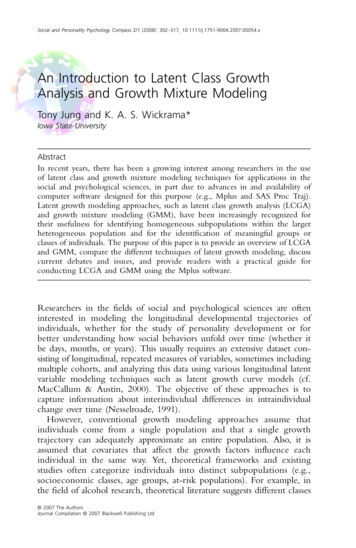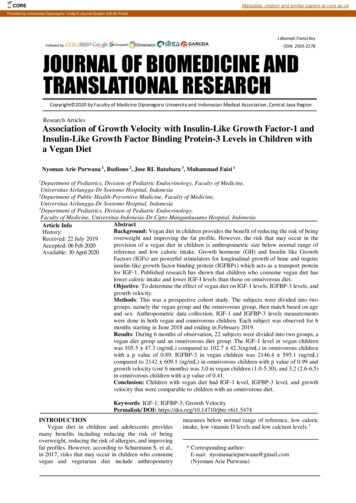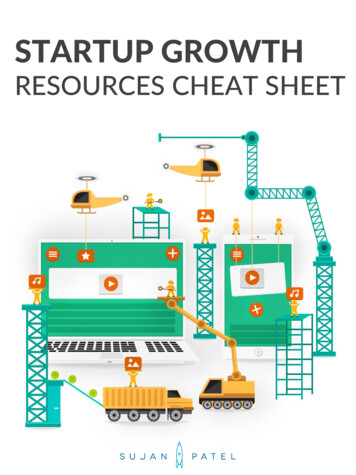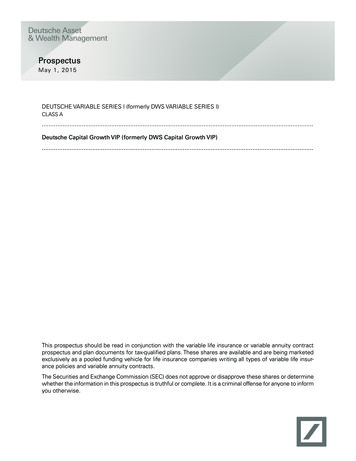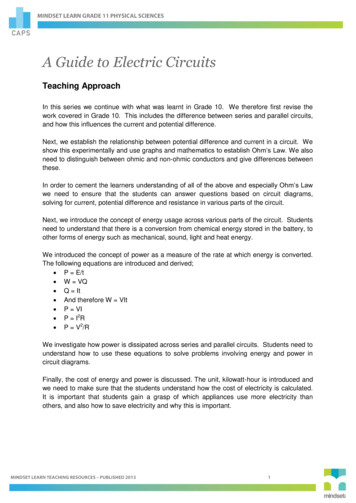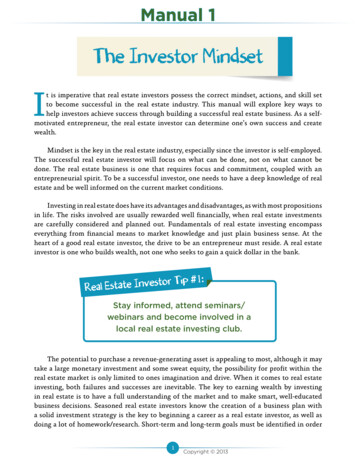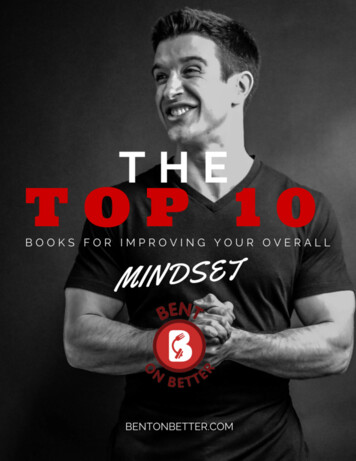
Transcription
Capital H: Season 6: Cultivating resilience througha growth mindsetDecember 2020LCAPITAL HGrowth mindsetCultivating resilience through a growth mindsetHost: Burt Rea, managing director, Research & Sensing, Deloitte Consulting LLPGuests: Jim Guszcza, fellow at Behavioral Sciences Department, Stanford University, previous US chief datascientist for Deloitte Consulting LLPAneeta Rattan, associate professor of Organizational Behavior, London Business SchoolIna Gantcheva, principal, Workforce Transformation, Deloitte Consulting LLPJulie Hiipakka, vice president, Research & Sensing, Deloitte Consulting LLPBurt Rea: Hello, and welcome back tothe Capital H podcast, where we explorethe topics and trends that focus onputting humans at the center of work.I’m your host, Burt Rea, and I lead DeloitteConsulting’s Human Capital Research &Sensing group. Today, we’ll be talking aboutgrowth mindset—the idea that our basicqualities and abilities as humans can becultivated through effort and persistence.In the workplace, a growth mindset canhelp create meaningful connectionsamong individuals and groups, even ifthose individuals and groups appear to beinherently different. As organizations moveto adopt more ethical standards, cultivatehuman capabilities, and increase diversity,equity, and inclusion, fostering a growthmindset among employees is becomingan important capability for human capitalleaders. To help us explore this conceptfurther, I’d like to welcome Jim Guszcza andAneeta Rattan. Jim is the former US chiefdata scientist for Deloitte Consulting and iscurrently a fellow at the Center for AdvancedStudy in Behavioral Sciences at Stanford. Dr.Aneeta Ratan is an associate professor ofOrganizational Behavior at London BusinessSchool. Jim, take it away!Jim Guszcza: Hello, everyone. My name is JimGuszcza, US chief data scientist at DeloitteConsulting. Today’s guest is someone I’veknown for several years now, ProfessorAneeta Rattan. Aneeta is an associateprofessor of Organizational Behavior atLondon Business School. Aneeta, welcome.Aneeta Rattan: Thank you so much, andthank you for inviting me, Jim.Jim: Yeah, it’s great to have you here. Let’sstart real simple. Aneeta, what is a growthmindset? Can you define it for us?
Capital H: Season 6 Cultivating resilience through a growth mindsetAneeta: I’m so glad that this is the startingquestion. It might seem silly to start out thisway. But I have to tell you, the word mindsetis so overused, both in the world and inorganizations that we really start to run therisk of not knowing what we’re talking aboutwhen we say a growth mindset.A growth mindset refers to a very specificpsychological construct. It has to do withwhether you generally believe that aparticular human characteristic or attributeis fixed, or whether you believe that it canchange. So, if you think about differenthuman attributes, think about intelligence,think about personality. You can even thinkabout prejudice or bias. Do you think thatthese characteristics can grow and developover time? If you do, you hold what we call agrowth mindset. Or do you think that thesedifferent attributes—intelligence, personality,prejudice—are fixed and unchanging overtime? If you believe that, then we would callyou more of a fixed mindset holder.I should mention that we use the termsgrowth and fixed mindset to refer to peoplewho fall more toward one end or the otherend of this dimension, of believing that thesecharacteristics are fixed or can change overtime. But they’re not really types of people.They don’t look different, they don’t talkdifferent. You wouldn’t necessarily evenknow what mindset someone holds from asingle conversation with them. We’re reallyjust characterizing this broad set of beliefsand where on this dimension of beliefspeople fall. A lot of people fall toward themiddle. And so a lot of people actually holdwhat we might think of as an undifferentiatedor maybe a mixed mindset, where they don’thold strong views one way or the other, andso then the situation can push them around.You mentioned both individual andorganizational mindsets earlier. It could bethat I personally believe that, let’s say, ability,intelligence are very fixed or can grow, but if I’msomeone who falls more toward the middle,maybe I also have a manager or a CEO who2really strongly communicates one of thosethings, and if that’s the case, I might shift myoutlook toward one direction or the other,depending upon which one they’re endorsing.Jim: That’s so interesting. I was wondering,does mindset or growth mindset, does thatrelate to any of the big five personality types.Aneeta: That’s a great question. What I willsay is that this is something that has beenstudied, but it was studied quite a few yearsago. And so it might be interesting to studyit again and get a kind of update on the stateof the evidence. As far as we know rightnow, when we think about mindsets, weneed to always, one, identify which domainof mindset we’re thinking about. So, if wethink about mindsets about intelligence,for example, we might think, well, if youthink your intelligence can grow, you mightbe more open to new topics, or thingsthat are different from what you’ve alreadyexperienced, so something that is morenontraditional, and that would fit that ideaof openness to experience, the personalitydimension that you referenced.What we know is that growth and fixedmindsets have a small correlation with someof the big five personalities you mentioned—openness to experience being one of them.But we don’t know about this whole other hostof different mindsets people might hold, likemindsets about personality itself, mindsetsabout prejudice, mindsets about groups. Andso I think there’s more research to be donethere. It’s a small correlation, which means thatthey’re definitely not the same thing.Jim: Yeah, they are distinct constructs. That’sa very good thing to point out. Anotherfollow-up question I had sparked by whatyou were just saying was, some people aresort of in the middle and if someone doesn’treally have a strong opinion one way oranother, the situational factors might haveinfluence whether they manifest more togrowth or fixed mindset. I think that’s whatI heard. Would that apply to if someonewho’s sort of in the middle goes to a verymeritocratic organization, where this idea ofmeritocracy, like the best and the brightestrise to the top, and some people are thenaturals, maybe that person can becomemore of a fixed mindset person. Is that areasonable speculation?Aneeta: One thing I should note is thatwe know from research that virtuallyanyone’s mindset can be shifted temporarilyby information that they’re given orby something that they’ve listened to,something that they read. So it’s not justthe people in the middle who can be shiftedaround. But having said that, yeah, thepeople in the middle, we probably don’tknow enough about them from the researchthat we have to date. But there is someresearch by a wonderful scholar namedMary Murphy, which suggests that peoplecan kind of absorb the mindsets of thepeople around them, whether that comesfrom their organization in general, whetherthat comes from a specific teacher. Some ofmy own research on mindsets also showsthat leaders in a situation can communicatea mindset, their mindset, to others.What we don’t know is whether thatfundamentally shapes people’s ownmindsets. What we do know is that thosekinds of signals from the environmentcan shape the way people act. In someof Mary’s work from a few years ago, shefound even that people will describethemselves differently when they’re applyingfor a student club or a job, they’ll describethemselves differently to match the mindsetof the context that they’re trying to enter.I think what you said about meritocracythere was really interesting because there’snothing about meritocracy itself, which isjust the idea that systems should be fair,that ties directly to a fixed mindset. It’s theway we tend to perform meritocracy thatends up tied to a fixed mindset. So, whenwe think about meritocracy, we think thesystem should be fair. That means that
Capital H: Season 6 Cultivating resilience through a growth mindsetpeople who perform better should thenrise to the top. If we think about the ideaof meritocracy as identifying those specialfew who have it, then we tie not just thefixed mindset to meritocracy, but also adifferent mindset, which I’ve studied, whichhas to do with our beliefs about whether thepotential for high intelligence is constrainedamong a select few, which we describe as anon-universal mindset versus is widespreadin the population, which we describe as auniversal mindset.So, the thing you said about meritocracyactually ties the fixed mindset and thisnon-universal mindset to meritocracy. And Ithink you’re right that that’s the way a lot ofpeople think about it and it can have reallyproblematic consequences.Jim: This actually leads very organicallyto the big question here, which is growthmindset is about, are these capabilitieskind of inherent or can they be changed?People’s growth mindset themselvescan be changed. In other words, can wedesign interventions, or can we designenvironmental tweaks that bring outgrowth mindsets in people?Aneeta: There are actually two questionsin your question. One is, can we changepeople’s mindsets? And then the other thatI think you’re probably asking about iscan we change people’s mindsets in waysthat have a big impact? So, can we havesmall shifts in mindset that actually havemeaningful consequences that we canobserve in the real world?We have a fair amount of research lookingat mindsets about intelligence or ability,and so I’ll give you my answer in terms ofthat mindset particularly. What we knowfrom that research is that it is possible tointervene and shift people’s mindsets. Todate, those interventions have not been asminimal as what we might think of as nudgeintervention. To date, those interventionshave really focused on describing this belief3to people, giving them vivid images that helpthem think about their abilities as somethingthat can grow. So, for example, thinkingabout the brain as a muscle, even though ofcourse the brain is not actually a muscle. Ifwe think about it that way we can rememberthat the harder we work at it, maybe thebetter it gets. And so we know that it ispossible to shift these mindsets in the shortterm, and actually in what I would think ofas the more longer term. Not necessarilythe long term as in years, but if researchlooks at what happens six months to a yearlater, we can actually observe benefits forperformance for individuals who’ve beenthrough a growth mindset interventionversus those who have not.Now, the question that you asked about was,can we shift them around with more subtlesignals? And do those more subtle signalshave a real observable, meaningful impact?And that’s really something that we still needto study. I think that many of us would loveto study it, because it’s not just, can we shiftaround mindsets with subtle signals? It’s,can we shift around mindsets using subtlesignals in the course of people’s everydaywork lives, when they have so much goingon around them, when they have so manydemands for their attention? And that is anincredibly important question. Anyone whois in an organization that’s ready to study it,please give me a call. Give me an email. I’mready to study it.Jim: This is so interesting. Let’s go back andunpack what you just said. Let’s go back tothe more intensive interventions. Correctme if I’m wrong, but those have been useda lot in primary and secondary schooleducation, right? You mentioned this idea ofthe mind is like a muscle. Could you maybejust unpack that a little bit?Aneeta: So, Carol Dweck, who really is thescholar who has identified, defined, andthen rigorously studied mindsets for years,has conducted research, both in researchlabs, in very controlled settings, and outthere in the real world where there’s a lotmore complexity and a lot more going on inpeople’s lives.She’s done these kinds of studies, bothin person with students in schools, andonline. And that work she’s done with oneof her former students, now a professorhimself, David Yeager. And what they havefound is that there are different types oftrainings that can be given to students inschools that communicate this idea of thegrowth mindset, that use the analogy of thebrain as a muscle, and that really challengestudents to think about their abilities, andwhere and how they can generate growthin their own abilities. So, when you strugglewith something, that gives you a signalof where you need to put more effort in.Now, what do you do? How do you put inthat effort? Who do you go to to ask forhelp, to be able to make that effort reallyactionable and useful? What they found intheir studies, which as I said, range from inperson interventions that can happen overa span of weeks, to online interventions,which can happen just within a single ormultiple session of someone interactingwith an online intervention, is that studentswho receive a growth mindset interventiondo show observable benefits for theirperformance. Some research out there, likeresearch by Susana Claro and Carol Dweck,show that this is particularly impactful onlow-income students.And one thing I want to highlight here is that,when I describe what the growth and fixedmindsets are, and I say they refer to people’sbeliefs about whether human characteristics,like intelligence, are fixed or unmalleable, itjust sounds so simple. And so, when I tell youthat we can shift people’s mindsets, and thenyield real results on something like grades,sometimes it sounds magical.Jim: Yep.
Capital H: Season 6 Cultivating resilience through a growth mindsetAneeta: Anytime something sounds magical,as I tell my MBA students, ask what’s reallygoing on. Sadly, for many of us in this world,there is no magic that we’ve seen or foundyet. What you’re really seeing when yousee a shift in performance as a function ofa mindset intervention is a complex set ofpsychological dynamics at play.The reason that mindset, and then thereforemindset interventions, can have suchprofound consequences on something someaningful as performance is becausemindsets are a fundamental belief. They’rea core way in which we see the world. Isometimes like to use the analogy of a pairof glasses. So, if you have a strong growthmindset, you’re looking at the world throughthe view that abilities can change in thecontext of intelligence.Jim: It’s a world view.Aneeta: Absolutely. You’re noticingopportunities for abilities to change. Whenyou’re struggling with something, you don’ttake it as personally and as defining assomeone with a fixed mindset might. Andthat has an impact on the way you respondto challenge. It also has an impact on theway, for example, teachers may give adviceto students, when teachers hold a growthversus a fixed mindset.And so, one thing that I really try to emphasizewhen I talk about mindsets is that thisresearch base comes from the world ofschools. Comes from the world of academia.And by virtue of that, it’s a world in whichlearning is prized and valued. And the settingis about both learning and performance.And so, in some respects, when we startthinking about mindsets, about intelligence,when we start thinking about how reliableare their effects, do they replicate acrosssituations? Across different age groups,for example. We really have to rememberthat this set of beliefs is something thatabsolutely exists across the life-span andacross contexts, but it might work a littlebit differently.4And so there is, I want to make sure Iacknowledge, there is research out therethat finds that mindsets do not predict theoutcomes that I’ve just been talking about.And in science, we think about this as mixedevidence. So there’s some evidence for this.There’s some evidence against it.Jim: You mentioned that in public schoolsettings, these interventions are sometimesparticularly effective with low-income students.Is it the case that cultural background affectsone’s mindset? Are fixed versus growthmindsets, are they characteristic of certainkinds of cultural backgrounds?What we see is that when we look across allthe studies that are out there, there doesseem to be a reliable effect of mindset onperformance in academic contexts. Butwhen we translate that into the world oforganizations, we have to really have cautionand be thoughtful because organizationsare different from schools. We all knowthat. Sometimes when I’m talking to peopleabout mindsets, I say, “How different is theplace you work from the classroom you satin when you were 14?” And people alwayslaugh as you’re doing right now. They alwayslaugh because their first response is, “It’ssuper different.”Aneeta: That’s a great question. Andit is absolutely the case that they arecharacteristic of certain kinds of culturalbackgrounds, because we’ve studied thatin certain kinds of cultural backgrounds.And until they have been studied in a reallywidespread way, we do need to make sure wethink about them within the context wherethey have been most rigorously studied.So, when we take this psychologicalconstruct that we’ve studied in schools,and we want to try and apply it and learnabout it in organizations, we really needto do the research and do the work to getan evidence base together, and make surethat we understand how the theory applies,if what we want to do is maybe act on themindsets that the people around us havein a way that would benefit them and theorganization as a whole.Jim: We’re all still learning, right? This isstill ongoing research. Maybe the exactinterventions that have proved successfulin academic settings, maybe they just haveto be tweaked a little bit for organizations.And that’s still experiments that we can do.Is that right?Aneeta: Absolutely. Yeah. So I’m not sayingat all that we need to start over in any way.What we have the incredible benefit of doingis building upon this profound and fantasticevidence base in the world of education,and saying, “Okay, where is it the same andwhere might it differ?”Aneeta: To date, what we know is that thesebeliefs about whether intelligence is fixed ormalleable, these beliefs actually do seem tobe fairly widespread. You can capture themacross cultures, from the US and Europe,all the way over to, let’s say, East Asia,China, and Japan, and South Asia, India, forexample. So, we know that we can measurethese beliefs almost anywhere in thecontext of intelligence. We also know that insome cultures, mindsets about intelligenceare far less predictive of people’s behaviorsthan in other cultures.So, for example, a researcher named SteveHina has found that while children in EastAsia might vary in their mindsets aboutwhether intelligence is fixed or can grow,they’re much more likely to respond to achallenge or a setback by putting in moreeffort. And that has to do, he theorizes, withthe types of schooling that is common there.With the kind of strategies and skills thatthey are trained in.In some of my own research, I’ve found thatmindsets about whether the potential forhigh intelligence is widespread or restrictedto a select few, these mindsets are morepredictive of outcomes within the USnational context than within Indian nationalcontext. And so I think we always need tothink about cultural context as a factor.
Capital H: Season 6 Cultivating resilience through a growth mindsetWe have to always consider how culture isshaping the questions we ask and the thingswe study. And the foundational researchon mindset has both found that thesemindsets exist across a lot of places in theworld, a lot of cultural context, and that it’sreally worthwhile and valuable to study howthey work and what they predict in thosecontexts, because it might differ.Within the United States, it is possible thatin schools that have really adopted thelanguage of a growth mindset, but let’simagine, might not have adopted a growthmindset in some of their practices, we mightfind different patterns than we would have20 years ago before this concept was morewidely publicized. I don’t know. I think that’sa really fascinating research question that’san open one, and one that relates to someof the trends we see in organizations, wheremore and more companies are starting totalk about mindsets, but not necessarilychange the structures and policies withinthe organization to align with the mindsetthey seem to be talking more about, which isthe growth mindset.Jim: That’s really interesting. Going backto the individual level, there’s a lot of talkabout automation and the future of workand how workplace is becoming moreinfused with technology. That implies thatpeople are going to have to change jobsmany times in their careers, people are livinglonger. And this idea of we’re all going to bestudents for our whole lives, and we don’treally know what the future holds for ourcareers. So, the journalist Tom Friedmanin the US said, “The future of work is a littlebit like comparing to the Olympics, but youdon’t know what sport you’ll be competingin. You just have to be prepared.” So, youcan imagine the growth mindset and thenkind of like black swan events like COVID,growth mindsets for both organizationsand individuals are going to become moreimportant than ever in an age when theworld is changing really quickly in ways youcan’t anticipate.5Aneeta: Absolutely. And I know youwere thinking about why companieshave suddenly pivoted toward this greatinterest in the growth mindset when, infact, the research has been ongoing formany decades in psychology. And I thinkwhat you’re talking about is exactly thereason why I think that more and morecompanies who realize that they exist inan environment that demands constantlearning and constant change. And that ifthey have created a culture in which theirpeople are afraid to admit they need tolearn something, if their people are unwillingto make changes because that mightundermine their pay or their longevity at thecompany or their progress within it, they’reactually hurting themselves. I also thinkthat in addition to the global pandemic,the recent movement around black livesmatter globally is really an opportunity forcompanies to take a growth mindset.A lot of my research focuses on trying tounderstand how growth mindset aboutpeople in general and about prejudice,so how growth mindsets, not necessarilyabout intelligence specifically, how theyrelate to people’s willingness to talk aboutthe really hard stuff, which has to do withdiversity, explicit bias, and then the overtconsequences of implicit bias. In otherwords, the kind of negative impact ofstructural or interpersonal implicit biaseson members of underrepresented groups.And again, this is a domain in which wedesperately need the world to change,but if people fail to believe that others canchange, they might actually hold themselves,hold those other people, and also holdorganizations back from progressing towarda world that is more equal and that doesrepresent the diversity that already existswithin it.Jim: Would it be fair to say that—or maybeI’ll ask the question as another hypothesis—that embracing growth mindsets is perhapsa promising way to advance the agenda ofdiversity and inclusion. Because if someonehas a growth mindset about their colleagues,they’re less likely to be anchored in an initialimpression or an initial implicit bias. Maybeit’s a way of breaking those implicit biases orexplicit biases. Is that a fair paraphrase?Aneeta: Yeah, I think that’s a fair hypothesis.So, in some of my research, what I findis that when individuals who come fromunderrepresented backgrounds, sowomen and racial minorities, when theyexperienced explicit or overt verbalcomments that are bias, they are actuallymore willing to confront those commentsand they cope relatively less negativelyafterwards when they hold the growthmindset. And so, the kind of bottom lineof that research is not that we should vieweveryone who expresses bias through thelens of the growth mindset, because somepeople don’t want to change. Some peopleactually have really thought through thesebeliefs and they hold very negatively biasedbeliefs toward outgroups, and they don’twant to change. The bottom line of thisresearch is instead to highlight that whenwe are able to view others through the lensof the growth mindset, we feel more able tospeak out and to disagree with commentsthat are biased against the identities that wehold. And that’s an empowering thing in andof itself. And we’re relatively less negativelyaffected afterwards. Of course, everyoneis negatively affected afterwards. What youwere hypothesizing about was a little bit onthe other side, which has to do perhaps withpeople’s receptivity to talking about issuesof diversity when one holds a growth or afixed mindset.We need to do much more research on that,of course. But we can draw some insightsfrom research that’s been done by PriyankaCarr, Kristin Pauker, along with Carol Dweckand then also by Jenessa Shapiro andRebecca Neil. What this collection of scholarshas found is that majority group memberswho view prejudice as changeable ratherthan fixed are more comfortable talkingabout bias, according to how they describe
Capital H: Season 6 Cultivating resilience through a growth mindsetthemselves when they think about it. Theyare more willing to learn about black history.And when they’re having a conversationwith another student on a topic related todiversity, they exhibit fewer signals of stress,so they seem like they’re more comfortable.Whether that translates to adults andto kinds of interactions that happen in aworkplace, we don’t yet know. It’s somethingthat many of us are actively studying.Jim: This is fantastic. This is a great note toclose our conversation on, Aneeta. Maybegoing up a level, it seems like we’ve learnedan incredible amount about how people’sself-conceptions can affect their behaviorand how we can actually design inventionsto improve people’s self-conceptions.We’ve learned a huge amount, especially inthe fields of education, but there’s still somuch to learn about how we can apply thisto the organizational level. But it’s a verypromising area to kind of take a scientificapproach to culture change, to improveperformance, to improve ethical behavior,to improve diversity and inclusion behaviorsin organizations. So, I want to thank you forjoining us and being so generous of yourtime and your insights.Jim: Thank you, Aneeta. Thank you so much.Aneeta: Thank you so much for inviting me.This is so fun.Burt Rea: Thank you to Aneeta for joiningus! It’s fascinating to hear about yourresearch and insights on growth mindsetand the potential for people, teams, andorganizational leaders to embrace and bringthis concept to life. Next I’d like to welcomea few of my colleagues to build upon Jimand Aneeta’s conversation by sharingperspectives on how applying a growthmindset can relate to organizational change,learning, and performance. I’d like to nowwelcome Julie Hiipakka, Ina Gantcheva, andJim Guszcza. Julie is a vice president with ourResearch and Sensing group within DeloitteHuman Capital. Julie leads our learningresearch team. Julie, please say hello.Julie Hiipakka: Hi, Burt. Thanks for having me.Burt: Wonderful. Great to have you here.Ina is a principal with Deloitte Human Capitalpractice. Ina is joining the podcast today.Welcome.Ina Gantcheva: Thanks for having me.Aneeta: Thank you so much. A final word.I would love to just underscore whatyou’ve said, which is that what we reallyneed in the world of organizations arepartnerships between researchers andorganizations so that we can do the kind ofrigorous empirical research that the worlddesperately needs to understand both whatworks and what doesn’t work. So, if we do amindset intervention and it doesn’t yield thebenefits we want for diversity inclusion, forperformance, for teams, for culture, we needto let the world know that. And that’s reallywhy I talk about it as a partnership, becauseit’s a partnership that helps us learn aboutthese basic psychological dynamics, but it’salso a partnership that helps organizationsknow what they can do versus what not todo in order to get reliable results.6do we bring that perspective to thinkingabout resilience, both for individuals, forteams, and for organizations? And, Jim, let’sstart with you.Jim: Thanks, Burt. So maybe we’ll justreview really quickly what a growth mindsetis, and I’ll say a few words about it. So, theidea of a growth mindset is a person has agrowth mindset if he or she kind of generallybelieves that a certain human characteristic,like a capability or intelligence, or personalitytype is fixed. Or whether that person thinksit can change. Even level of happiness. So, ifsomeone believes that those capabilities—intelligence, personality, happiness, evenlevels of bias or prejudice—if someonebelieves those are sort of malleable througheffort, that person has a growth mindset.Otherwise, we say that person has a fixedmindset. And it has been a very influentialbody of thinking in public school educationin particular. I think that right now, it’s apretty exciting area to investigate in theorganizational context, especially whenwe’re thinking about culture change andenabling organizations to be more nimble intimes of change.Jim: Thank you. Good to be here.Burt: Jim, I love that contrast of growthmindset and fixed mindset. And I think thatis really essential to the resilience that weneed right now, to the creativity that weneed right now. If any of us were to saywe’re in a fixed world, we would be living ina fantasy. Ina, I’d love to bring you into theconversation. How do we use this idea ofgrowth mindset to attract and retain morethan our fair share of the best talent?Burt: So, I’d like us to maybe build on theconversation that Jim and Aneeta just hadby hearing perspectives on how growthmindset relates to organizational change,learning, and performance. And
a growth mindset December 2020 Cultivating resilience through a growth mindset Burt Rea: Hello, and welcome back to the Capital H podcast, where we explore the topics and trends that focus on putting humans at the center of work. I’m your host, Burt Rea, and I lead Deloitte
